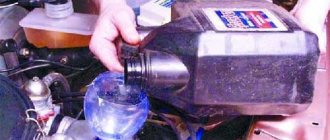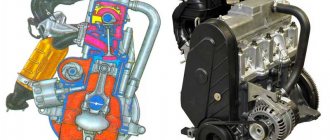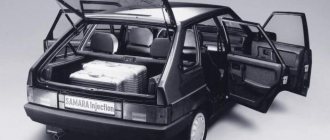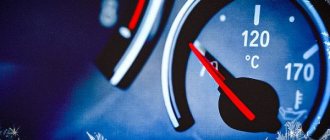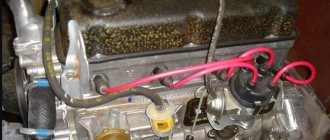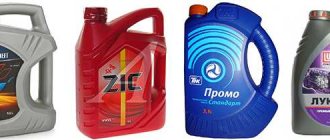Any car deteriorates and wears out over time, and this applies not only to the body or interior elements. Much more trouble for car owners is caused by malfunctions of the engine and other vehicle systems that arise as a result of long-term use of the vehicle.
Sooner or later, every driver is faced with the need to overhaul the power unit, which involves replacing most of the components of the cylinder-piston group and the crank mechanism. The result is an engine that has been updated almost to its original condition, which at first must be run in in the same way as a completely new car.
Of course, there are some differences, and we will definitely talk about them in our review.
How to run-in an engine after a major overhaul?
Proper engine running-in after overhaul is an important measure for its further long-term operation. Many drivers are well aware that after a major overhaul the engine requires proper running-in. A well-performed run-in makes it possible to increase the service life of the engine, its efficiency and throttle response by 20%.
The most common are hot and cold running. During hot running-in, the engine runs directly on the car, in motion, and during cold running-in, an electric motor is connected to the motor, rotating the power unit.
Typically, a major engine overhaul at a car service center does not include a cold run-in, because not all workshops are equipped with such break-in stands. Therefore, the driver will have to break in the engine himself. In order to perform the break-in correctly, you need to familiarize yourself with the procedure for carrying out this procedure and not violate the break-in period.
How long to break in the engine and how to do it
The first 1000 km are considered the most important. During this period, it is not recommended to travel at speeds above 60 km/h: it is better not to engage fifth speed at all. During the initial run-in, bluish smoke may appear from the muffler pipe: there is no need to panic: this is natural, since new piston rings are being broken in. Unstable idle is also not a reason to worry. Adjustment should be done after 500-1000 km. How long does it take to break in the engine in total? After the car has traveled 2.5-3 thousand km, increase the maximum speed to 85-90 km/h, gradually increasing the load. The engine can be considered finally run-in after running 8-10 thousand km.
Break-in features
Concepts such as engine overhaul and overhaul should not be confused. If the engine is overhauled, only a few operations are performed: replacing oil seals and caps. A major overhaul involves complete disassembly, troubleshooting, washing and replacement of damaged and worn parts, their adjustment to the required dimensions. Such work includes: grinding the crankshaft, installing new connecting rod bearings, boring the block, etc.
Major repairs are not cheap and are carried out only by professional craftsmen. As a result, the car owner will receive a rebuilt engine with the parameters of a new power unit. The break-in rules are identical for both new and refurbished engines. Installation of new parts, as well as machined surfaces, requires lapping of parts for further work.
General rules
- Do not apply engine braking, brake or accelerate.
- You cannot tow a trailer or another vehicle or transport large loads.
- You should not drive at the same rpm and speed.
- Driving at low speeds is prohibited.
The engine should not be overloaded; the loads should be small and increase slowly. During the break-in period, it is not advisable to allow the engine to idle for a long time, except when warming up; idling in this case is a difficult mode for the engine.
After the 1st thousand km, it is imperative to change the engine oil and filter. Additives and additives are not allowed. Let's take a closer look at running in the engine after repairs. The engine requires that all components and parts get used to each other.
Lapping concerns for restored engines of the cylinder-piston group, crankshaft and connecting rods, and gas distribution mechanism. The engine will have to be run in for at least 3000 km. If the repair was only on the camshaft and cylinder head, then running in 1000 km is enough. The most popular overhaul was the option with a complete engine restoration, so we will consider this.
- Before starting to drive, the engine should be warmed up at idle speed, then warmed up while driving to operating temperature.
- It is better to plan the route in advance so that the road surface is smooth without large descents and ascents. It is advisable that only the driver be in the car.
- When driving, it is forbidden to use engine braking, sharply brake or accelerate, and avoid jerking.
- It is not recommended to accelerate faster than 60 km per hour, or increase engine speed above 2500 rpm.
- Do not allow tight movement, as well as frequent movement at low engine speeds of about 1000 rpm.
- Driving with a monotonous load on the engine should not be allowed. In other words, it is not recommended to stay in one gear for a long time. It is better to smoothly change the load, sometimes accelerating and braking, but at the same time it is necessary to correctly select the gearbox so that the engine operates in the medium speed range. This method allows the piston rings to find their place in the piston grooves, and a cylinder mirror is formed. Even the best thorough polishing is not able to perfectly level out all the roughness, which can only be removed by rolling.
The generally accepted running-in rate of 3000 km is the smallest. Full high-quality grinding of parts on most engines ends after 10 thousand kilometers. And throughout this entire period it is also recommended to comply with the running-in conditions, but less strictly. Only after a complete break-in and passage of the specified period can the engine be subjected to load, smoothly and slowly increasing it from medium values to high values, and then to the highest.
Run-in mode after major overhaul
8. After this, you can drive out onto the road. At the same time, do not exceed the speed of 60-70 km per hour . It is better not to engage fifth gear during this period. The first 300-500 km are the most critical, do not overload the engine. The appearance of bluish smoke from the muffler is a normal situation, especially if a new set of piston rings is installed. There may also be some instability in the idle speed, which should be finely adjusted after 500-1000 km . 9. After 2500-3000 km , the maximum speed can be increased to 80-90 km/h.
to change the oil and filter after a run of 2500 km During this period, many wear products appear in the oil.
After changing the oil, do not forget to also tighten the accessible threaded connections (cylinder head, oil pan, front cover, starter, generator, etc.), adjust the valve clearances, idle speed, and timing belt (chain) tension. When extraneous noises and knocks appear, you must definitely find their source.
These simple operations will allow you to properly break in your car's engine. The most common mistake during break-in is running in high gears and, accordingly, low engine speeds - this cannot be done, because At this time, the engine is overloaded due to insufficient oil pressure.
Signs of improper break-in: oil in the air cleaner, high fuel consumption, low power, oil consumption, problems starting the engine.
As you can see, the running-in process requires precise implementation of the technology. To avoid possible problems with engine break-in, manufacturers use special break-in additives, such as WINDIGO ECO-Universal Oil Package. The additive will ensure ideal “grinding in” of surfaces, protect new parts from scuffing, and your investment in major repairs will ensure a long service life of the overhauled engine. The use of WINDIGO additives during break-in allows you to reduce the break-in time by 2 times, as well as avoid possible problems with “grinding” and jamming of engine parts. Additives also eliminate scuffing that has occurred on the surface of parts if the engine has not been run in correctly.
First launch after repair
- Before starting the engine and during break-in, it is necessary to ensure that the battery is well charged. When first starting, the engine is difficult to crank. The starter must also be in full working order.
- You should use only high-quality oil and fill it at the upper level of the dipstick. At the same time, remember that the oil cannot quickly drain into the engine sump. You should also not pour oil into the filter to avoid air pockets created by the filter oil.
- Lubricants and coolants should not be filled above the level, as exceeding the volume will lead to leaks and various malfunctions. After starting the engine, the pressure should reach normal values at idle. Do not add gas if the pressure does not return to normal and the control lamp does not go out. In this case, the engine must be turned off quickly.
- Restart the engine. In the same situation, you need to look for a malfunction in the lubrication system. If you continue to operate the engine without operating pressure, you will have to start overhauling the engine again.
- If the pressure in the lubrication system quickly returns to normal, then you can warm up the engine. As the temperature rises, the oil becomes more liquid, so the pressure should decrease slightly and reach operating values, but not less than 0.8 kg per cm2.
- As the engine warms up, it is necessary to carefully visually inspect it to determine any leaks of oil and various working fluids. If there are leaks, then the engine is stopped and the leakage problem is eliminated.
- If the pressure is normal and the engine is dry, free of leaks, and running smoothly, it is recommended to listen to the engine for any extraneous noise.
Steady normal operation of the engine means that you can begin running in under load. Take a short drive while watching the lubrication system pressure warning light, as well as the power unit temperature on the dashboard. After driving 3 kilometers, you need to stop and see if there are any leaks of engine fluids.
Next, you need to stop the engine, wait 15 minutes, pull out the dipstick and check the oil level. If it has become a little less, then you should top it up to the middle between the minimum and maximum levels.
Stable operation of the engine and all systems indicates that the engine can be operated and run-in. To get good results and increase the life of the motor, you must follow the tips discussed above.
Change of oil
As a result of break-in, steel shavings appear in the engine, which penetrate the engine oil and settle in the oil filter. These chips must be removed from the motor. This is done by draining the oil and replacing the filter. This work must be done every 1000 km. Engine break-in oil is poured immediately after engine repairs are completed, before starting, and during further replacement only high-quality oil of the appropriate brand and viscosity. This means that it is necessary to use only oil recommended by the factory.
It is also necessary to take into account that after boring the cylinders to repair sizes, experts often advise using thicker oil compared to a new engine.
Around the bend
Yes, friends, sometimes troubles happen that entail a major overhaul of the engine or, more simply put, a major overhaul. Just like a new engine that has been overhauled by motorists, it also needs competent running-in with an understanding of the essence of the issue. Unfortunately, both in the case of a new engine and in the case of a rebuilt one, many motorists are completely unaware of such a process as break-in.
Since our resource is aimed primarily at novice motorists, we will not go into technical issues with a bunch of incomprehensible words, but will consider the case when your car had an engine overhaul, but was not really explained what to do afterwards. Unfortunately, this is exactly what happens in many cases, which was the reason for writing this note. So, let's go.
The 1st stage is very important. In fact, you determine the future “life” of the engine with it. For the first two stages, you just need to forget about at least some noticeable load on the engine. Simply put, it should operate at 60% load compared to normal operation. For simplicity, let's highlight a few points here:
- Regularly checking the levels of working fluids (in this case, it is the engine low and the coolant level).
- Good warm up to operating temperature. If you are wondering why you need to warm up the engine before driving, I recommend reading a note on the topic. Well, if we are talking about the process of running in the engine after a major overhaul, then there cannot be any “buts”. It definitely needs heating. And not just up to 40-50°C, but up to the operating temperature, which is approximately 84-93°C.
- Smooth start and smoothest braking.
- Smooth and accurate operation of the gas pedal.
- Constant monitoring of engine speed, which in run-in mode should not exceed 3000 rpm.
- Engine temperature monitoring.
- Availability of a supply of engine oil and coolant in the trunk. Although this should always be with you, or rather with your car.
- Do not transport heavy loads, much less a trailer.
This is interesting: Territory survey report sample 2021
Stage 2 is the most difficult. Its difficulty is that if it is not so difficult to withstand 500 km, then another 2000 or more can already begin to cause irritation. But we have something to endure for. It’s very good if at this stage you have a need to visit your grandmother in another city and a significant part of it will fall on this route. In the summer this is easier, although in the summer heat it is harder on the engine. In general, if it works out, good. No - oh well, go about your business, just always remember to be extremely careful and smooth.
Some advise driving long distances at a stable speed during the break-in period, while others, on the contrary, recommend letting the engine run in different modes. Let's still choose something in between and without fanaticism, because despite all the importance, this is not the most important thing in your life. You are not for the car, but the car is for you.
As a conclusion, I would like to say once again that engine overhaul is not a reason to sell a car. It may happen that a restored motor will last you much longer than a new one, as is very often the case. In general, my advice to you is to treat this issue philosophically, just like others. “Nothing lasts forever under the sun,” including you and me and our cars. Regular inspection of the car, elimination of minor faults, use of high-quality spare parts and consumables is the key to the health of your iron friend!
And yes, do not forget to hang a sign on the back with the large inscription “BREAK-IN” while the engine is running in after the overhaul. This way, you won’t irritate other drivers with your sluggish acceleration and leisurely maneuvers, and you will be treated with understanding.
Cold running on the bench
The most accurate and correct method of grinding in new parts in a repair engine is cold running on special equipment. For this purpose, a specialized stand is used, which is not available at all car services and service stations. It makes it possible to quickly and efficiently carry out the engine break-in procedure. At the same time, full control over the functioning of the motor is carried out, and any inaccuracies and malfunctions in operation are eliminated during the running-in process.
The method under consideration is also called cold lapping, based on the principle of its operation on the bench. Having fixed the engine in a certain place, its crankshaft is connected to an electric motor, which will drive and transmit torque to the car engine. Then the engine oil of the appropriate brand is poured into the power unit, and the cooling system is connected. The parameters and characteristics of the engine are checked using an electronic control system, which eliminates errors during run-in, since the stand operates according to a customized program.
Another smoking engine on video
Any car deteriorates and wears out over time, and this applies not only to the body or interior elements. Much more trouble for car owners is caused by malfunctions of the engine and other vehicle systems that arise as a result of long-term use of the vehicle.
Sooner or later, every driver is faced with the need to overhaul the power unit, which involves replacing most of the components of the cylinder-piston group and the crank mechanism. The result is an engine that has been updated almost to its original condition, which at first must be run in in the same way as a completely new car.
Of course, there are some differences, and we will definitely talk about them in our review.
Benchless cold running
This method is some attempt to simulate the work of a running stand. The procedure is that the engine will quickly dry out if it does not heat up from the use of any fuel, and its rotation is ensured by external mechanisms.
The work is done like this: The car is coupled with a tow rope to another car and towed in gear for several hours. This makes it possible to quickly run-in the engine, but does not allow control over the operation and execution of any algorithms. How well the engine was run-in can be judged by the mileage and achievements until the next repair.
There are methods that make it possible to find out whether the engine has been successfully run-in, and when using the cold method, these signs are clearly visible:
- The car became more dynamic in motion and gained more power.
- The engine started starting much faster.
- The engine idles has become more stable and maintains speed in compliance with standard values.
Hot running-in of the engine
This is the most popular method used in engine repair shops and by experienced craftsmen. Sometimes it is used in conjunction with natural running. The procedure is performed at idle, but with different engine speeds and different ranges of its operation.
The engine is first started for a short time, not exceeding 3 minutes. But this process is repeated more than once. Between these starts, the engine must cool down, otherwise the engine may overheat in places where parts rub.
After completing a cycle of short-term starts, which allows for initial or quick grinding in of parts, the engine starts for 1 hour. During this period, the engine speed is slowly increased, then at the end of the process the speed should not be more than half the maximum permissible speed for this type of power unit. During the entire procedure, you need to monitor the heating of the motor, and if the temperature is exceeded, then you need to urgently stop the engine, and after it has cooled down, perform all the steps again. You need to monitor the oil and antifreeze levels, monitor all gaskets and connections for fluid leaks.
After this, the run-in was carried out. But it should be said that experts also advise carrying out a natural run-in, which will guarantee the full running-in of all engine parts.
First start of the power unit
Assembling the motor is an extremely important stage. Any mistake can have very serious negative consequences. The first start of the engine after repair work is no less important. We can say that following the correct sequence of actions largely determines how successful the subsequent running-in of the engine will be.
Here is the algorithm for the first engine start after a major overhaul:
- make sure that the battery is fully charged - due to the presence of micro-irregularities, all its power may be needed to turn the crankshaft;
- Great importance should be given to engine oil: it must not only correspond to that recommended for a given engine, but also be of high quality. Filling the MM should be carried out to the upper limit mark of the dipstick - after 15 minutes, some of the oil will drain into the pan, and it may need to be topped up, but this time not reaching the MAX mark. It is not recommended to pour lubricating fluid into the oil filter - inept performance of this operation can lead to the formation of an air plug in the oil line;
- for diesel and carburetor power units, fuel must be supplied to the system manually;
- If all preparatory manipulations have been completed, you can start starting the engine. In this case, be sure to check the oil pressure lamp. Compared to a normal start, it should burn a few seconds longer, but if after 5-7 seconds it does not go out, you should immediately turn off the engine and begin to find out the reason why the oil pressure was not brought back to normal;
- When starting the engine with the starter, do not help it with the accelerator - the increased load here is not only inappropriate, but unacceptable. But the depressed clutch will come in handy;
- If the light goes out, you should warm up the engine to 85-92°C at idle speed, without gases. While the engine is warming up, you can look into the engine compartment and under the car to make sure there are no leaks of technical fluids, including oil and antifreeze. Remember that the appearance of a burning smell during the first start-up after capitalization is normal; this is the result of burnout of lubricants applied during engine assembly. After the power unit reaches operating temperatures, there will be a slight drop in the MM pressure in the system, as the hot liquid becomes more liquid. Acceptable pressure is considered to be in the range of 0.4-0.85 kg/cm2. If it is less, it means that there are problems that arose either as a result of assembly errors or due to the use of low-quality lubricating fluid;
- After warming up, the engine must be turned off and started back only after it has cooled to 40 degrees. About one and a half dozen such engine start/stop cycles should be carried out, after which you can let the engine run at higher speeds (for the first three minutes - at a thousand rpm, then for four to five minutes - at one and a half thousand rpm, after which Let the engine run at 2 thousand rpm for 5 minutes).
Running in a diesel car
There are no big differences in the running-in procedure for gasoline and diesel cars. To reduce friction in the engine, there is a lubrication system. The oil pump pumps up the required pressure, which drives engine oil through the oil channels and rubbing parts. A film of oil is created between them, popularly called an oil wedge.
It is necessary to carry out the diesel engine break-in procedure with an emphasis on the optimal pressure created in the lubrication system and at the same time minimizing the load. Effective pressure is considered when the crankshaft rotation speed is 1300 rpm. Travel at lower engine speeds is not recommended.
- The mileage of the first 1000 km is the most critical when running in a diesel engine.
- Before driving, warm up the engine to 30 degrees. Next, the diesel itself will warm up while driving.
- You should not engage a gear higher than second with a manual transmission. On an automatic transmission, it is better to block the transition beyond the second gear.
- Engine speed must be maintained within 1500 rpm.
- After warming up, you can increase the speed, but not higher than 4th gear. When running in, do not overload the engine.
- It is better to test the car outside the city, since you will not need to stand at traffic lights and brake frequently.
- When driving on a straight road, you can engage fourth gear and move at a speed not exceeding 80 km per hour. When climbing, it is better to switch to a lower gear.
It is recommended to stop at least 2 times during one trip and turn off the engine, allow it to cool, check the oil and coolant levels. If possible, check the oil in the automatic transmission. After checking the oil, do not close the hood yet, start the engine and listen to the sound of its operation, test the operation of the electrical equipment. Such checks must be carried out before a mileage of 1000 km.
This is the lowest mileage for running a diesel engine. At this time, you must strictly follow all the rules. Then you can gradually increase the load. Qualified experts express the opinion that the best mileage for running in a diesel and gasoline engine is 10 thousand km. Although some craftsmen claim that the process of grinding in parts ends only after a mileage of 30 thousand km.
Didn't find the information you are looking for? on our forum.

